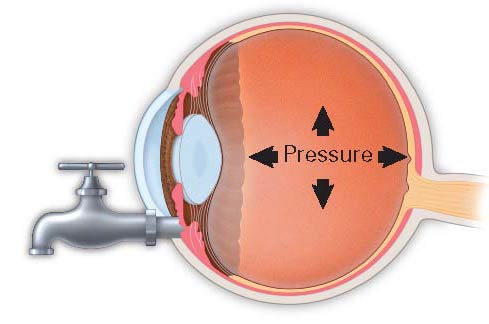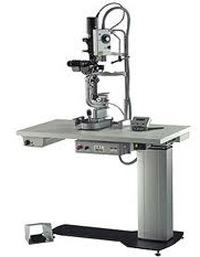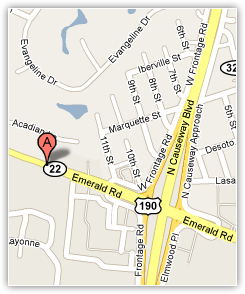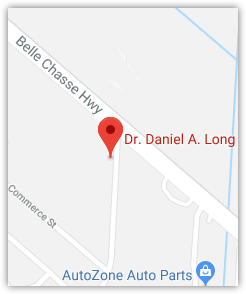Glaucoma is one of the leading causes of blindness in the United States and the single most common cause of blindness in African-Americans. Glaucoma has often been referred to as “the silent thief of sight” since most people with the disease are unaware that they have it until detected by an eye physician. It may cause permanent vision loss if not detected and treated early. Since the damage caused by glaucoma is irreversible, early detection is extremely important.
Glaucoma occurs when pressure within the eye is elevated enough to cause progressive damage to the optic nerve. This first results in loss of peripheral vision and then, in the later stages, loss of central vision.

There are several risk factors that increase a person’s chance of developing glaucoma. They include increasing age, African-American ethnicity, family history of the disease, high blood pressure, diabetes, long-term steroid treatment, nearsightedness, and eye injuries.
A comprehensive eye examination is the first step in detecting glaucoma. During this exam, the doctors at Caplan Eye Clinic will perform several tests that will provide clues as to whether or not a person is a “suspect” for the disease. One such test is tonometry, better known as “the eye pressure test.” Elevated intraocular pressure is one of the first signs of glaucoma. However, sometimes patients may have normal eye pressure and still have glaucoma. That is why it is important for the doctor to perform a dilated retinal exam, which allows an evaluation of the optic nerve. The appearance of the optic nerve is another key factor in diagnosing glaucoma. Once the doctor deems the patient a “glaucoma suspect,” various tests are performed. One of the newest high tech instruments for evaluating and following glaucoma is Optical Coherence Tomography (OCT). This device performs a laser scan of the optic nerve in just a few seconds in our office. It provides a very detailed evaluation of the health of the optic nerve. Another test that we perform is the visual field test. This test is a very sensitive way of evaluating peripheral vision and, hence, detecting glaucoma. The earlier the disease is detected, the better chance a person has for preserving his or her vision.

The goal in glaucoma treatment is to prevent further optic nerve damage and visual field loss by lowering intraocular pressure. This is achieved either by medication (usually in the form of eye drops) or by surgery (primarily in the form of laser). Drops are the first type of therapy instituted in most cases. The newest and most effective laser treatment for glaucoma is Selective Laser Trabeculoplasty (SLT). In just a few minutes right in our office, SLT laser may be performed to better control glaucoma. At Caplan Eye Clinic, we have always invested in the latest proven technology to enhance and preserve eyesight.
Once target intraocular pressure has been reached, it will usually be monitored every 3-4 months. A dilated retinal exam and a visual field test will need to be performed yearly to monitor any disease progression. These follow-up appointments are very important in the proper management of glaucoma. For complex Glaucoma patients, we also offer appointments with Dr. Ze Zhang and Dr. Lauren Lim, two fellowship trained Glaucoma specialists. For more information about glaucoma, or to schedule an eye examination, call Caplan Eye Clinic at 504-888-2600.
Glaucoma Treatments
Selective Laser Trabeculoplasty (SLT) For Glaucoma
 Laser has become increasingly popular as an effective treatment for glaucoma. Selective Laser Trabeculoplasty (SLT) is an established laser treatment for open-angle glaucoma. SLT uses short pulses of low energy laser light to target melanin-containing cells in a network of tiny channels, called the trabecular meshwork. The objective of the laser procedure is to help fluid drain out of the eye, reducing intra-ocular pressure that can cause damage to the optic nerve and loss of vision.
Laser has become increasingly popular as an effective treatment for glaucoma. Selective Laser Trabeculoplasty (SLT) is an established laser treatment for open-angle glaucoma. SLT uses short pulses of low energy laser light to target melanin-containing cells in a network of tiny channels, called the trabecular meshwork. The objective of the laser procedure is to help fluid drain out of the eye, reducing intra-ocular pressure that can cause damage to the optic nerve and loss of vision.
The selective technique is much less traumatic to the eye than Argon Laser Trabeculoplasty (ALT), which had been the standard laser procedure. SLT reduces intraocular pressure without the risk of tissue damage which occurred with ALT. SLT can be used to effectively treat some patients who could not benefit from ALT. This includes patients who have already been treated with ALT.
In many cases, you will need to keep taking glaucoma drugs even after laser procedure, although many patients will not require drops after SLT treatment.
SLT is for those:
- who have been diagnosed with glaucoma
- whose doctor has determined that SLT is appropriate for controlling their intra-ocular pressure
What to expect on procedure day:
Your treatment will be performed in a specially equipped laser room located at the Metairie office at Caplan Eye Clinic. Once you have been checked in and are settled comfortably, drops will be used to numb your eye; no injections or needles are used. Since no other anesthesia is needed, you may usually drive yourself to and from the Clinic. No other special preparations are required.
Dr. Caplan or Dr. Sumich will hold up a special lens to your eye as the laser light is aimed at the lens and reflected onto the meshwork inside your eye. You may see flashes of bright green or red light. The laser will selectively target melanin-containing cells, resulting in increased fluid outflow. You will not feel any pain during the procedure. It takes just a few minutes to perform the laser treatment, but the entire process may take an hour or so.
 Your eye pressure will be checked shortly after your procedure and drops may be prescribed to alleviate any mild soreness. You should relax for the rest of the day. Follow-up visits are necessary to monitor your eye pressure. While it may take a few weeks to see the full pressure-lowering effect of this procedure, during which time you may have to continue taking your medication, many patients are eventually able to discontinue some of their medications. .
Your eye pressure will be checked shortly after your procedure and drops may be prescribed to alleviate any mild soreness. You should relax for the rest of the day. Follow-up visits are necessary to monitor your eye pressure. While it may take a few weeks to see the full pressure-lowering effect of this procedure, during which time you may have to continue taking your medication, many patients are eventually able to discontinue some of their medications. .
Realistic expectations:
The effect of the surgery may wear off over time. Serious complications with SLT are extremely rare, but like any laser or surgical procedure, it does have some risks. Going to a specialist experienced in SLT can minimize the risks.
If Dr. Caplan or Dr. Sumich decides that SLT is an option for you, you will be given additional information about the procedure that will allow you to make an informed decision about whether to proceed. Be sure you have all your questions answered to your satisfaction. If you would like more information about this procedure you can make an appointment or contact Caplan Eye Clinic for additional information.

















